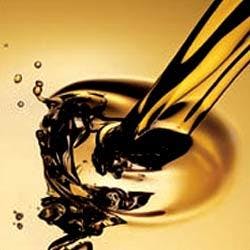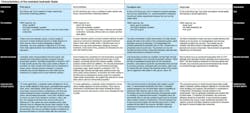This file type includes high resolution graphics and schematics when applicable.
Even though most oil-based hydraulic fluids have relatively high flash/fire points (>300° F), small leaks in a high-pressure system can produce a finely atomized spray that can travel significant distances. If an ignition source is encountered, complete ignition of the spray envelope can occur. The alternative is to use a hydraulic fluid that eliminates or significantly reduces this hazard: any of several fire-resistant hydraulic fluids (FRHFs).
The decision to purchase a higher-priced FRHF is perhaps analogous to our income tax dilemma this month; you don't want to pay it, but the alternative is worse. However, there is more to know about FRHFs than just price; there are significant chemical and performance differences that must be understood before specifying a FRHF for any given application. To address this need, this article will briefly review the evolution of FRHFs, the types of fluids that are commercially available, and the advantages and disadvantages associated with each.
How far we've come
The history of FRHF is relatively simple and has been one of slow evolution. As the name implies, the original fluid medium in hydraulic applications was water, and it offered the highest degree of fire resistance possible. However, an acceleration in the performance potential of fluid power systems dictated a need for much better lubricating requirements that could be satisfied only by oil-based fluids.
Apart from isolated segments of basic research, little progress was made in developing suitable FRHFs until the end of World War II. During the war, tragic incidents related to hydraulic fluid fires and major property losses at steel mills and foundries graphically illustrated the urgent need for something to be done. Similar incidents in captive environments such as coal mines during the rapid post-war industrial expansion helped motivate a major joint research effort between government and industry. This work was directed at developing fluids that could replace oil-based hydraulic fluids at a reasonable cost and with no significant reduction in hydraulic system performance. Two basic approaches were undertaken. One involved the introduction of water into the fluid to act as a "snuffer" if the fluid ignited. The other involved synthetic, non-aqueous products whose chemistry resisted burning or generated products of combustion that helped extinguish any flame.
Commercial products in both categories evolved during the 1950s and '60s and are still in use today. In the early 1970s, an additional synthetic type of fluid was introduced to address many of the drawbacks inherent in the earlier types. Since the introduction of each type, many improvements have been made in fire resistance, anti-wear properties, and overall quality.
Where we are
Water glycol and invert emulsion constitute the major fluid types of water-containing products. Water glycol is a true solution of a glycol (such as ethylene glycol) in water, along with a variety of additives to impart viscosity, corrosion protection, and anti-wear properties. A shear-stable thickener, which has improved over the years, represents the novel technology aspect of the fluid. Water glycol contains approximately 40% water. Despite a number of drawbacks, water glycol is the dominant FRHF on the market today and is used in a wide variety of applications.
An invert emulsion also contains approximately 40% water but is a stable emulsion of water dispersed in oil. The outer phase, oil, represents the wetting surface; the inner phase, water, provides the fire retardant-element. Oil-soluble additives provide anti-wear properties, corrosion protection, and emulsion stability. Inverts, at one time, were commonly used but are losing favor in industry today.
Synthetic fluids initially were represented by a class of chemical compounds known as phosphate esters, which are reaction products between phosphoric acid and aromatic ring-structure alcohols. These fluids are extremely fire resistant and have widespread industrial use, as well as military and aircraft service. However, their popularity has declined because of environmental, cost, and compatibility factors.
The other type of synthetic fluids in use are synthetic hydrocarbons, more specifically, polyol esters. These fluids are the reaction products between long-chain fatty acids (derived from animal and vegetable fats) and synthesized organic alcohols. These products contain additives to impart anti-wear properties, corrosion protection, and viscosity modification. Fire resistance results from a combination of high thermal properties and physical characteristics. This is the most recent category of FRHFs and has gained widespread and growing use.
What is fire resistance?
The term "fire resistant" often is misunderstood or interpreted to be overly inclusive; it seems appropriate to standardize the terminology and review the accepted test methods for judging the fire resistance of a given fluid. First, there is no single property or test of a fluid, such as flash/fire point, auto ignition temperature (AIT), etc. that will quantitatively rate its relative fire resistance. This has led to a "simulated incident" approach in which tests are designed to replicate a worst-case scenario in typical applications where fluid power is used near a potential fire hazard. Fluids generally pass or fail these tests, and those that pass are incorporated into an Approval Guide or List of Qualified Fluids.
In the United States, two test protocols have evolved and are generally regarded as benchmarks in the industry. One was developed by Factory Mutual Research Corporation (FMRC). Their original intent was to use the test results in the risk-assessment programs of those insurance companies under the Factory Mutual System umbrella. The test has since become the chief qualification for commercial companies using FRHFs; all fluid suppliers submit products seeking "FMRC Approval." The 1992 FMRC Approval Guide lists over 300 FRHFs from approximately 50 suppliers. Factory Mutual's program is now global in scope.
FMRC addresses the definition of FRHF in the following excerpt in their introduction to the hydraulic fluids sections of their Approval Guide:
Less flammable hydraulic fluids approved and listed here have been tested to evaluate fire hazard only. All presently available fluids will burn under certain conditions. In each case the fire hazard has been reduced to an acceptable degree, meeting the Approval Standards of FMRC; other fluid properties are not investigated.
This paragraph accurately puts the intent of FRHFs into the proper perspective. They are not fireproof but, rather, they significantly reduce the potential hazard associated with oil-based products. In the FMRC tests, the fluid is conditioned to 140° F, pressurized to 1000 psi in a steel cylinder, and discharged through an oil burner-type nozzle. The spray generated is intended to simulate a high-pressure hydraulic system leak. A gas flame is passed through (not retained in) the spray envelope at two distances downstream of the nozzle. There may be local burning at the point of flame entry, and the pass criteria dictate that any flame must self-extinguish when the ignition source is removed; no flame may propagate back to the nozzle. This process is repeated 20 times, and the burn duration timed. Any burn duration over 5 sec is considered a fail.
A second test uses the same spray directed at an inclined metal channelheated to 1300° F. In this test, the spray is continuous for 60 sec. The criteria are:
1. The spray in contact with the channel may not burn, or
2 If spray ignition takes place, fluid rolling off the channel cannot continue to burn, and the flame cannot follow the spray if directed away from the channel.
If these conditions are satisfied, the fluid is approved. Statistics are not available, but many products in all of the fluid categories described do not pass this test.
The Mine Safety & Health Administration (MSHA) has had in place for many years an evaluation program for qualifying fluids that are used underground, primarily in coal mines. MSHA testing is similar to FMRC's in the sense that a spray mist of the candidate fluid is generated. However, the ignition mechanism is somewhat different in the MSHA test. Under this procedure, a spray mist is directed continuously at a variety of ignition sources that include an open gas flame, a welding arc, and burning rags. The passl criteria are that localized burning in the spray mist extinguish within 5 sec, and there can be no sustained propagation along the spray axis. They also have an AIT criterion and a wick test to assess the rate of evaporation of water from a candidate product. MSHA tests also have a relatively high rate of product rejections.
Since both of these tests involve fluids submitted by the supplier to the testing agency, both FMRC and MSHA have comprehensive manufacturer auditing programs in which quality-assurance programs are carefully evaluated and monitored by periodic, on-site inspections. This may include retests of approved fluids.
Other tests
In addition to these "third party" ratings of FRHFs, many companies have developed their own fire-resistance tests that must be considered in addition to a product having FMRC approval. Again, these tests generally follow the simulated incident philosophy and are specific to the type of industry involved. Examples of these include exposing the candidate fluid &emdash; in spray or non-spray form &emdash; to a hot manifold, molten metal, heated blocks of a representative metal, burning rags, hot sand, etc. The evaluation criteria may be no burning, limited burning, no smoke, non-propagation, etc. Minimum AIT and flash/fire point temperatures also are used either independently or in combination with a test described above.
In all of these tests, a product is either approved or rejected; there is no ranking or rating of approved products. This aspect, the occasional lack of reproducibility, and the absence of service history of a fluid has led FMRC to develop a new test that will quantify the relative fire resistance of various fluids. The test procedure involves measuring the heat release of a fluid under a fixed-burn condition and combining this value with a separately determined measurement of the energy required to initiate burning. These values are used to establish a Spray Flammability Parameter for each product evaluated. This test and a new approval standard currently are under review by FMRC and have not been formally adopted.
Other concerns
The major problem facing a designer converting a hydraulic system from an oil-based fluid to FRHF is selecting the particular type that will minimize the cost of conversion and maximize the operating and safety benefits. The choice becomes a trade-off of characteristics associated with each type. Each product group offers advantages and disadvantages for any given application. It is beyond the scope of this article to attempt to make recommendations for certain end-users, but the major attributes and shortfalls of the various fluid types can be addressed.
The table above summarizes these characteristics, price ranges, and some of the considerations associated with converting a system containing oil-based fluid to a FRHF. Many suppliers offer products for each type of FRHF, which may vary considerably in price, quality, and after-sale service.
Where we're going
With regard to future developments, there are no new products on the horizon which will make this process any easier. Significant improvements have been made in recent years with both water glycol and polyol ester fluids, and this trend should continue. Moreover, the impact of more-stringent environmental regulations will be more strongly felt in the next few years and may even restrict the choice. The motivation for converting from an oil-based fluid will also strengthen as waste control regulations expand for any product containing oil. In some areas, "hydraulic oil" already is considered a hazardous material. Fluids having the capability of being non-toxic and readily biodegradable will further expand the need to replace oil-based hydraulic fluids.
Bob Gere, retired, is a fluid power consultant, and Tom Hazelton is manager, fluid power, Quaker Chemical Corp., Conshohocken, Pa. For more information, visit www.quakerchem.com.
This file type includes high resolution graphics and schematics when applicable.




